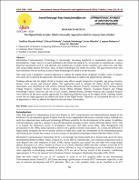The digital divide in India: Which universality approach is ideal for gujarat state of India?

View/
Date
2014Author
Mayoka Kituyi, Geoffrey
Kabaale, Edward
Nakabonge, Fatinah
Mbarika, Irene
Balunywa, Luqman
Mbarika, Victor W.
Metadata
Show full item recordAbstract
Information Communication Technology is increasingly becoming beneficial to humankind, given the latest developments. Today, there is so much potential to the extent that using ICTs, we are able to communicate, conduct financial transactions such as cash deposits and withdrawals at banks, money transfers, pay school fees and other bills using mobile phones. However, most, of these technologies are within few hands. The gap between those who have and those who do not have access to these technologies in India is on the increase.
This study used a qualitative research approach to explore the digital divide challenge in India’s state of Gujarat. The study also examined the approaches that had been undertaken to address the digital divide challenge.
Findings indicate that the digital divide in Gujarat state affects people irrespective of gender, age group, location, literacy level, income and physical ability. The approaches used to mitigate the digital divide and enhance universality were identified as Call Centres, Internet Kiosks, Bhoomi Projects, Gyandoot Projects, Warana Wired Village Projects, Common Service Centers, Social Media, Drishtee Projects, Gyandoot Projects and Village Knowledge Centres. However, the use of Call Centres, Internet Kiosks, Drishtee Projects and Gyandoot Projects were found to be the most suitable approaches for addressing different forms of the digital divide. Findings further reveal that no single approach can address all forms of the digital divide. Therefore, we recommend the use of a set of approaches in order to address the digital divide and foster Universality.
